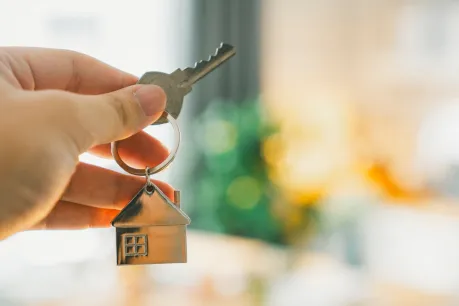Watch Your Step! The Hidden Dangers of Residential Slip and Falls

Injured?
Your home is supposed to be your safe haven, but slip and fall accidents can happen anywhere, including residential properties such as homes or apartment buildings. Many hazards can cause slip and fall accidents, so it's important for tenants, homeowners, and landlords to understand common causes, liability issues, and what steps to take after an accident.
Common Causes of Slip and Fall Accidents in Residential Properties
Slip and fall accidents are often caused by everyday hazards that go unnoticed until an issue arises and they cause harm. Some of the most typical dangers in residential spaces are:
Poorly Maintained Stairs
Worn-out or uneven steps, broken treads, or absent anti-slip strips can easily cause falls, especially for elderly residents or those with mobility challenges.
Slippery Surfaces
Areas prone to water exposure, such as bathrooms, kitchens, and entryways, can all become slippery, increasing the risk of a bad fall.
Loose Carpets and Rugs
Unsecured or fraying carpets pose a tripping hazard, particularly at thresholds or staircases where footing can be easily misjudged.
Clutter and Obstructions
Maintaining clear pathways in residential spaces is essential for preventing accidents. Items left in hallways, on stairs, or walking paths can quickly become tripping hazards.
Poor Lighting
Dim or broken lighting, particularly in stairwells and entryways, makes it difficult to see potential hazards, increasing the risk of a slip or fall.
Faulty Handrails
When handrails are loose, broken, or missing, individuals are more likely to lose their balance and fall.
Who Is Liable for a Slip and Fall in a Residential Setting?
Liability in a slip and fall incident depends on who is responsible for the area where the accident occurred. A slip and fall accident lawyer can help you determine if the landlord, a tenant, a homeowner, or a property management company was at fault for your accident.
Landlords and Property Owners
Landlords are generally responsible for maintaining safe communal or shared areas. They could be held liable if they fail to repair or address known hazards in their apartment building lobbies, entrance ways, stairwells, and sidewalks.
Tenants
Tenants have some responsibility to keep their living spaces free from hazards in rental properties; however, they may not be held liable if a slip and fall is caused by structural or maintenance issues that fall under the landlord’s jurisdiction.
Homeowners
Homeowners who invite guests onto their property must ensure the premises are reasonably safe. They may be held liable for injuries to their guests if they slip and fall due to an obvious hazard.
Property Management Companies
Landlords sometimes hire property management firms to manage their properties. These companies may be liable for property upkeep if they fail to fulfill their duties, such as repairing staircases or maintaining lighting.
Landlord Responsibilities for Tenant Safety
Landlords are legally responsible for maintaining their tenants' safe and habitable living conditions. This duty includes addressing hazards that could lead to slip and fall accidents, as these incidents can result in liability for landlords if negligence is involved. In situations where a tenant asks, “Can you sue the landlord for falling on property?” the answer often depends on whether the landlord has met specific responsibilities, including:
Routine Inspections
The landlord must regularly inspect common areas to detect and address hazards like loose carpeting, broken handrails, and uneven floors before they cause harm.
Timely Repairs
When a landlord is informed of a safety issue, they must address it promptly. The landlord is responsible for repairing broken steps, fixing inadequate lighting, and addressing water leaks.
Building Code Compliance
Landlords must ensure that their properties meet local building codes, which often specify requirements for stairway dimensions, handrail height, and adequate lighting in common areas to protect tenants and visitors from potential falls.
Steps to Take After a Slip and Fall in a Residential Building
If you have suffered a slip and fall in an apartment building, here are the steps you should immediately follow to ensure your rights are protected:
- Seek Medical Attention: Even if injuries seem minor, always prioritize your health.
- Document the Scene: Take photos of the accident scene, including the hazard that contributed to the fall.
- Report the Accident: Notify the landlord, property manager, or homeowner immediately.
- Gather Documentation: Gather witness information, incident reports, and medical records to build a strong case.
- Consult an Attorney: If you believe the incident was due to negligence, a slip and fall lawyer can help you understand your rights and determine whether you have grounds for a claim.
Taking these steps ensures that you receive the necessary medical care and have the documentation needed to support a potential claim.
How Homeowner’s Insurance Affects Slip and Fall Claims
Homeowner’s insurance can be vital in covering medical expenses and other liabilities following a slip and fall accident. While insurance policies vary, most typically cover the following:
Medical Payments Coverage
Many homeowners insurance policies include coverage for medical expenses related to injuries on the property, regardless of who is at fault. This coverage can help with immediate medical bills for the injured party.
Liability Coverage
If the homeowner is found liable for the slip and fall incident, liability coverage may help pay for legal expenses, settlements, or judgments arising from a lawsuit.
Filing a Claim
After a slip and fall accident, the homeowner can file a claim with their insurance provider. Documentation, such as photographs, witness statements, and medical records, will be important in helping the insurer assess liability and coverage.
Policy Exclusions
Some policies may have exclusions, especially if the accident occurred due to gross negligence or intentional misconduct. Reviewing the policy’s terms can clarify coverage for slip and fall incidents.
Slip and Fall Injuries at Home: Your Questions Answered
Who is responsible for a slip and fall accident on a rented property - the landlord or the tenant?
The responsibility for a slip and fall accident on a rented property depends on where the accident occurred. Landlords are generally responsible for maintaining safe conditions in common areas, such as stairways, walkways, entryways, and sidewalks. They are also typically responsible for addressing structural issues throughout the building. Tenants, however, are accountable for hazards within their rented units unless the problem is related to a structural concern or landlord negligence.
What should I do if I slipped and fell in my apartment building’s common area?
If you slip and fall in a common area, immediately report the incident to your landlord or property manager. Seek medical attention, document the scene with photos, gather witness contact information if possible, and record any injury-related expenses. A slip and fall accident lawyer can help you understand your rights and seek the compensation you deserve.
Can I sue my neighbor if I slip and fall at their home?
Yes, you may be able to sue if the fall was due to a hazardous condition the homeowner neglected, such as an unmarked slippery floor, loose handrails, or poor lighting. Homeowners are generally responsible for maintaining safe conditions for visitors, and their homeowner's insurance may cover the claim if they are found liable.
Does a homeowner’s insurance cover slip and fall accidents on residential properties?
Homeowner’s insurance typically covers slip and fall accidents, providing liability coverage for medical expenses, legal fees, and compensation if the homeowner is found at fault. Some policies may cover immediate medical expenses regardless of fault under a provision known as "medical payments" coverage. This can help with initial costs for injuries sustained on the property without establishing liability. However, an investigation into the property conditions and potential hazards would still be necessary for full compensation related to negligence, as coverage specifics can vary widely by policy.
What evidence should I gather after a slip and fall accident at a residential property?
Gathering as much evidence as possible after a slip and fall accident may help to substantiate your claim. Photos of the scene, any visible hazards, and your injuries, as well as medical records, incident reports, witness statements, contact information, and any communication with the building manager or landlord, can support your claim and help prove negligence if you decide to pursue compensation.
How do I prove that a landlord’s negligence caused my slip and fall accident?
To prove that a landlord’s negligence caused your slip and fall accident, you must show that a hazardous condition existed, the landlord knew or should have known about it, they failed to address it promptly, and this failure directly caused your injuries. Documentation, inspection records, repair requests, and witness statements can help support your case.
What happens if my slip and fall accident was caused by a temporary condition, like ice or water, on a neighbor’s property?
If a temporary hazard like ice or water caused your fall, the homeowner might still be liable if they failed to take reasonable steps to address it within a reasonable timeframe. In many cases, proving negligence in temporary conditions depends on how long the hazard existed and whether the homeowner was aware of it or should have been aware.
How Morgan & Morgan Can Help
Residential slip and fall accidents can have serious consequences, but knowing what hazards to watch for, understanding liability, and being aware of insurance options can make a big difference.
If you or a loved one has been involved in a residential slip and fall accident, Morgan & Morgan can help you understand your rights and pursue compensation for your injuries. Our experienced attorneys are dedicated to holding property owners accountable and ensuring victims receive the support they deserve. Contact us today to get started with a free case evaluation.

We've got your back
Injured?
Not sure what to do next?
We'll guide you through everything you need to know.
